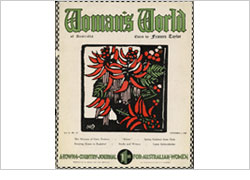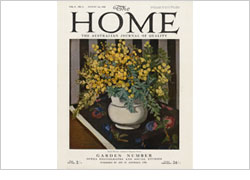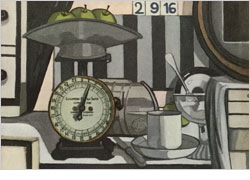|
|
|
 |
 |
1923
*‘ … Australia is a fine place in which
to think. The galleries are so well fenced in. The theatres and
cinemas are so well fenced in … The universities are so well
fenced in … Tradition thinks for you, but Heavens! How dull!
(‘Why I became a convert to modern
art’, The Home June 1923) |
|
|
 |
 |
1924
*‘If Australia is ever to have a typical art
of its own, the less it sees of mediocre English or European works
the better …’
(‘Should there be an Australian tariff
on imported works of Art?’ Art in Australia June
1924)
|
Image: Margaret Preston c.1924 (detail). Photograph
by Harold Cazneaux. Preston archive, Art Gallery of New South Wales
|
|
 |
 |
1925
*‘In wishing to rid myself of the mannerisms
of a country other than my own I have gone to the art of a people
who had never seen or known anything different from themselves …
These are the Australian Aboriginals and it is only from the art
of such people in any land that a national art can spring’
(‘The Indigenous Art of Australia’,
Art in Australia March 1925)
|
Image: Woman’s World October 1926 with Preston’s Coral
flowers (1925) on cover. Preston archive, Art Gallery of
New South Wales
|
|
 |
 |
1927
*‘Art is the tangible symbol of the spirit
of a country … What is Australia going to offer to the world
as her contribution to the Arts?’
(‘What is to be our National Art?’,
Undergrowth March–April 1927)
|
Image above: Cover for The Home August 1928
with Preston’s Wattle (1928). Caroline Simpson Library
& Research Collection, Historic Houses Trust of NSW
Image above right: Still life
1927 (detail) untraced
|
|
 |
 |
*-‘Yet again
the old restless feeling is bothering her. She feels that her art
does not suit the times, that her mentality has changed and that
her work is not following her mind. She feels that this is a mechanical
age – a scientific one-highly civilised and unaesthetic. She
knows that the time has come to express her surroundings in her
work .All around her in the simple domestic life is machinery –
patent ice chests that need no ice, machinery does it; irons heated
by invisible heat; washing-up machines; electric sweepers and so
on. They all surround her and influence her mind … ’
(Preston speaking of herself, ‘From
Eggs to Electrolux’, Art in Australia December 1927) |
|
 |
 |
1929
*-‘Modern art is attached to science. The
world that science is making may be disgusting but it is the world
in which we have to live and it condemns to futility all who are
too blind to notice it’
*-‘The easiest way to understand modern art
is to buy an example and live with it. Custom makes consciousness’
Margaret Preston Aphorisms:
(Art in Australia, 1929)
|
Image: The Home, June 1929 with Preston’s
Lobster (1929) on front cover. Caroline Simpson Library
& Research Collection, Historic Houses Trust of NSW
|
|
 |
 |
*-‘Modern art,
to survive, must be made necessary to modern society. The first
step is to find subjects that can symbolise what is to us the meaning
of our world as effectively as the religious pictures once did for
other times
*-‘Why there are so many tables of still life
in modern paintings is because they are really laboratory tables
on which aesthetic problems can be isolated’
*-‘Colour is the emblem of change’
Margaret Preston Aphorisms:
(Art in Australia, 1929) |
Image: Cover for The Wentworth Magazine,
August 1928 with Preston’s Christmas bells (1925)
|
|
 |
 |
*-‘Colour is the
emblem of change’
*-‘Imitators serve only to emphasise the greatness
of their master’
*-‘Art to fulfil its destiny, requires to
be accepted by a nation or race and not by the few’
*-‘Art never improves, only changes’
Margaret Preston Aphorisms:
(Art in Australia, 1929) |
Image: Margaret
Preston in her Mosman garden 1930 (detail).
Photograph by Harold Cazneaux. Preston archive, Art Gallery
of New South Wales
|
|
 |
|
 |






![]()
















